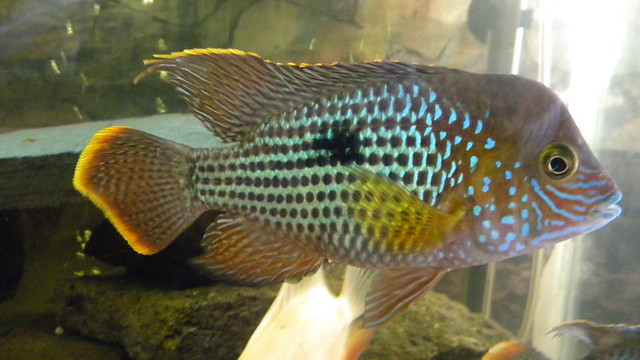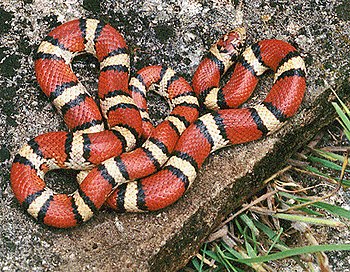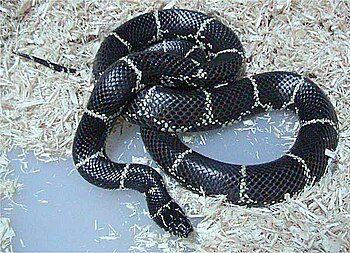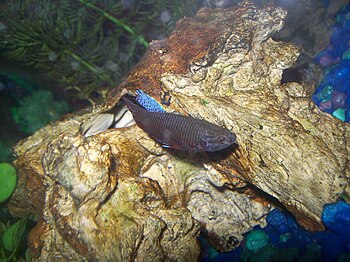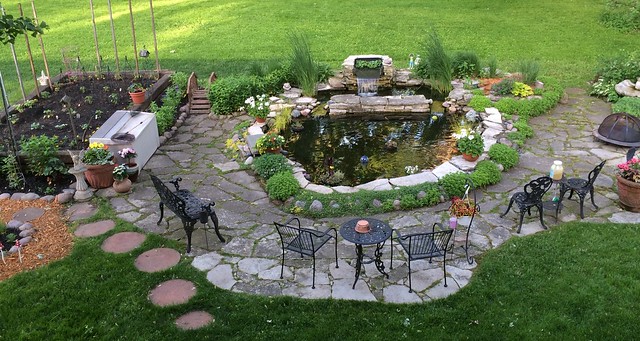 |
| Photo by NOAA Photo Library |
This is one of the larger dwarf angles, growing to as long as 6 inches in length as an adult. The anterior body region and caudal fins of these are canary yellows. Their posteriors are royal purple or blue sometimes with thin, barely perceptible, vertical bars that are only slightly lighter in color than the posterior coloration. These fish also have a single purple bar that starts at one eye and loops around the top of their head and then terminates at the other eye. This fish is also marketed by the aquarium trade under the name Oriole Angel.
Bicolor angelfish carry a moderate care level. They can be successfully raised by aquarists of intermediate skill levels. This is among the most peaceful of the commercially available angelfish varieties. They make wonderful additions to a multi-species aquarium provided they are housed with fish of similar size and temperament. Angles often demonstrate territorial aggression toward conspecifics and similar looking species. Bi-colors can be kept together if they are introduced to an aquarium simultaneously as young juveniles. This will allow them to grow up in a small community rather than being introduced to a member of the same species after they have had a chance to establish territorial boundaries. As with any family, intermediate squabbling may still occur on occasion. This species is rated reef safe with caution.
The younger they are when added to a marine reef aquarium, the less likely they are to come to realize that many of its inhabitants are prime menu choices in the wild. Adult bicolors spend an exorbitant amount of time grazing on the naturally occurring algae growing on live rocks. An abundance of cure live rock is mandatory for keeping this species vigorous and healthy as adults. A well-feed angelfish will be far less likely to nibble on a coral or crustacean and discover a tasty new treat. A minimum tank size of 50 gallons is recommended for this species. Angelfish are more sensitive to unhealthy water parameters than many marine species. Due diligence should be practiced in maintaining clean, clear water. Under premium conditions, you can expect these fish to live up to 12 years of age.
This is an omnivorous species. Like many angelfish, this species diet changes considerably between juveniles and adults. Juveniles feed primarily on plankton. Newly hatched brine shrimp mixed with increasing amounts of flake, frozen or freeze-dried food will help them become accustomed to nonliving food items. An adult's diet consists of algae, worms and small crustaceans and clams in their natural habitat. A high-quality marine preparation specially formulated for marine angels will make an ideal staple. Their diet can be further supplemented with freshly chopped crustacean, mollusks, dried or frozen algae and table vegetables such as spinach, zucchini, and yellow squash. Once again, an abundance of cured live rock will help ensure their nutritional needs are properly addressed.
The males and females of this species are virtually identical in size and coloration. This may be because they are protogynous synchronous hermaphrodites. All fish will initially develop into females. Should prorogation of the species demand it, the largest most dominant female will transform into a male. Several juveniles introduced into an aquarium together will result in a single male and a harem of females. This fish has been known to breed in captivity but reported incidents are rare.
Technological advancements in the aquarium industry continually redefine the concept of "home aquarium owner." Just twenty years ago not even the biggest public aquarium was capable of keeping jellyfish alive in captivity. Now they make desktop Jellyfish Fish Tank Aquariums. And why would you want a jellyfish tank? Perhaps you should check out what the translucent bodies of Pet Moon Jellyfish look like under LED lighting. Pet Jellyfish give a whole new meaning to the term exotic pets. Article Source: EzineArticles |


